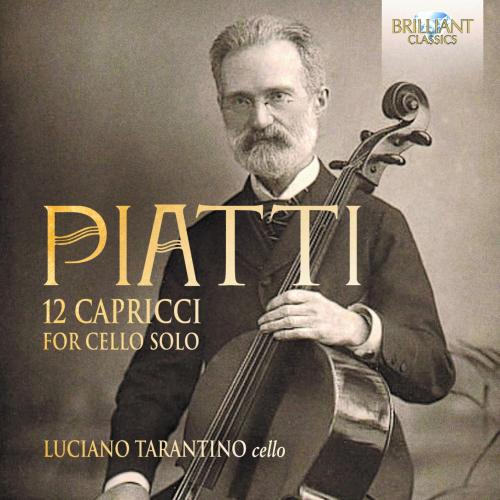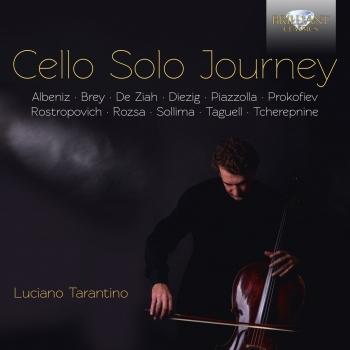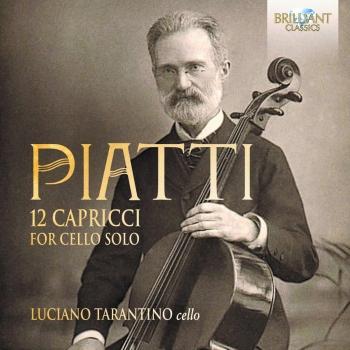
Piatti: 12 Capricci for Cello Solo Luciano Tarantino
Album info
Album-Release:
2022
HRA-Release:
31.12.2021
Label: Brilliant Classics
Genre: Classical
Subgenre: Chamber Music
Artist: Luciano Tarantino
Composer: Alfredo Piatti (1822-1901)
Album including Album cover
- Alfredo Piatti (1822 - 1901): 12 Capricci for Cello Solo, Op. 25:
- 1 Piatti: 12 Capricci for Cello Solo, Op. 25: I. Allegro quasi presto 01:36
- 2 Piatti: 12 Capricci for Cello Solo, Op. 25: II. Andante religioso 06:23
- 3 Piatti: 12 Capricci for Cello Solo, Op. 25: III. Moderato 02:15
- 4 Piatti: 12 Capricci for Cello Solo, Op. 25: IV. Allegretto 04:29
- 5 Piatti: 12 Capricci for Cello Solo, Op. 25: V. Allegro comodo 03:21
- 6 Piatti: 12 Capricci for Cello Solo, Op. 25: VI. Adagio largamente 04:14
- 7 Piatti: 12 Capricci for Cello Solo, Op. 25: VII. Maestoso 02:52
- 8 Piatti: 12 Capricci for Cello Solo, Op. 25: VIII. Moderato ma energico 02:47
- 9 Piatti: 12 Capricci for Cello Solo, Op. 25: IX. Allegro bene spiccato 02:02
- 10 Piatti: 12 Capricci for Cello Solo, Op. 25: X. Allegro deciso 03:23
- 11 Piatti: 12 Capricci for Cello Solo, Op. 25: XI. Adagio-Allegro 03:50
- 12 Piatti: 12 Capricci for Cello Solo, Op. 25: XII. Allegretto capriccioso 03:51
Info for Piatti: 12 Capricci for Cello Solo
Alfredo Carlo Piatti began a precocious and distinguished career as a cellist in his native Bergamo, as well as in Turin and Milan. He left Italy at 21 to seek his fortune and on his travels met Franz Liszt, who gave him an Amati cello, and Felix Mendelssohn, who conducted one of his first concerts in London. In early 1847, having performed across Europe and with considerable experience under his belt, he settled permanently in London.
After enjoying an illustrious half-century among the upper echelons of London’s musical elite, he returned to Italy in 1898 and spent his final years living with his daughter and editing his body of compositions. On his death in 1901, he bequeathed the Fondo Piatti-Lochis to the city of Bergamo, a precious collection of manuscript and print editions of his entire oeuvre, containing around 60 instrumental pieces, a similar number of short vocal compositions and around 40 transcriptions and reworkings of music by major composers of the past. It includes the first edition (produced by Piatti himself) and two autograph manuscripts of his 12 Caprices Op.25. Both manuscripts bear the same date: ‘London, 26 June 1865’.
The Caprices became Piatti’s best-known compositions, and they have been recorded and performed by cellists all over the world, who find them difficult to master but also undoubtedly an extremely interesting challenge. Within them, Piatti explores the full technical and expressive potential of his instrument. The left hand is forced into possible and seemingly impossible positions, often giving the impression of flying rapidly and lightly over the strings, while the right hand adroitly manages the bow, testing out all the various ways of generating sounds and traversing all pitches and tonal colours. Mastering the Caprices can therefore be seen as a way of achieving the playing technique described in a first-hand account of one of Piatti’s last concerts: ‘He diligently interprets the thinking hidden in the music, liberating it with his divine instrument; in his expert, awe-inspiring hands it speaks and sings sometimes sweetly, sometimes loudly, sometimes trembling, but always disciplined and convincing’.
Luciano Tarantino, cello
Luciano Tarantino
Born in 1977; he begins the study of the cello at the age of 10 years; he gets a diploma with the maximum of the vows in a few years at the Conservatoire “N.Piccinni” of Bari with the master G. Melisi. At the age of 16 years he wins a scholarship for young talents promoted by UE, and he is admitted to attend the cello course held by M° Franco Maggio Ormezowski, at the Academy “Arturo Toscanini“ of Bologna. Under the guide of the Master Ormezowski for further 10 years, and at the same time under the guide of M° Geringas, Monighetti, Slowacewski, Smith, Mork and Rostropovich he acquires such a great experience and ability, so that at the age of 20, he is qualified to the competition to become a member of the Symphonic Orchestra of RAI (Radio-Television-Italian), where he worked for 7 years. He participates in numerous International Competitions, coming among the first places. He plays as first cello in numerous and prestigious Italian and foreign orchestras under the direction of masters such as: Lorin Mazeel, Aleksandr Lazarev, George Pehlivanian, Eliahu Inbal, Walter Attanasi, Jeffrey Tate, Valerij Gergiev, Georges Pretre, Gianandrea Noseda, Giuseppe Sinopoli, Yutaka Sado, Kirill Petrenko, Zoltàn Peskò, Lù Jia, Rafael Frùhbeck de Burgos, Simon Pretre, Daniel Oren, and others. As regards his chamber music career, he has been involved involved in different formations which span from the duet to the octet, in performances in International theatres like Kabukiza in Tokyo, Operà Garnier in Paris, Real Theatre in Madrid, Hall Petrassi, Hall Sinopoli , Parco of the Musical park in Rome, beside Moscow, Vilnius, Stockholm, Istanbul, Peking, Seoul, Strasburgo, Lugano, Johannesburg, Beirut, etc.
He is Teacher of Cello at the State School “Giustina Rocca“ of Trani. In May 2014 he founds the Cultural Association “Note di Notte” and he gives start to numerous musical reviews under his artistic direction. He plays a precious Italian cello “Carlo Antonio Testore 1736”.
This album contains no booklet.
















